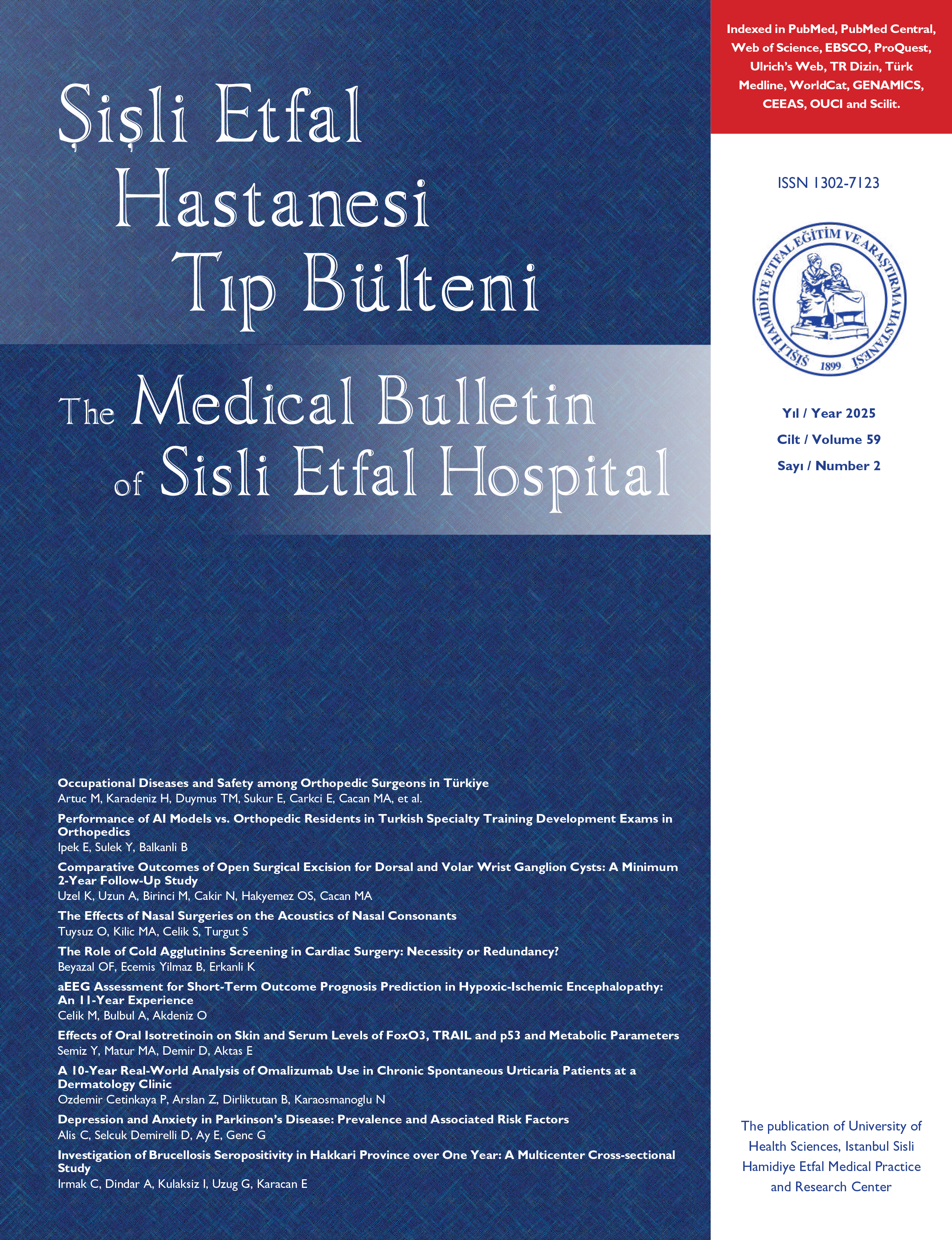
Evaluation of tissue transglutaminase IgA antibody in diagnosis and following up of celiac disease in children
Seda Geylani Güleç1, Nafiye Urgancı2, Filiz Gül1, Merve Emecen1, Ela Erdem11Department of Pediatrics, Şişli Etfal Training and Research Hospital, Istanbul, Turkey2Department of Pediatric Gastroenterology, Istanbul, Turkey
Aim: It is studied to challenge a costeffective, easy applicable, diagnostic algorithm that has high spesivity an sensitivity in pediatric patients with celiac disease.In our study we aimed to determine the relationship between a quick and easy finger tip celiac disease test and the other tests in addition to effective of diet monitorization.
Patients and Method: 33 (64.7%) of the cases was girl and 18 (35.3%) was boy and the patients were 1-17 (6.59±4.51) years old. All of the patients were diagnosed as celiac disease by upper gastrointestinal endoscopy. There is no patient detected with selective IgA deficiency. 36% of patients were adapted to diet and 15% was not. Tissue transglutaminase (tTG) IgA was performed by immuno-cromatographic method called Biocard Celiac test (AniBiotech, Vantaa, Finland). Statistical analysis were done with NCSS 2007 programme.
Results: tTG IgA test was positive in 24 and negative in 27 patients. tTG IgA, antigliadin antibody (AGA IgG) and antiendomisium antibody (EMA IgA) were consistent as diagnosing methods. tTG IgA test was 100% positive in diet non adapted group where as 75% was negative in diet adapted group (p=0.002). There is no statistical difference in terms of AGA IgA, AGA IgG and EMA IgA in diet adapted or non adapted gruops (p=0.119, p=0.083, p=0.419). There is no difference between AGA IgA and AGA IgG (p=0.241). There is statistical difference between AGA IgA and EMA IgA (p=0.001) and no statistical difference was detected between AGA IgA and IgG (p=0.098).
Discussion: Cromatographic detection of tissue transglutaminase which is an easy applicable and cheap test is consistent with EMA IgA test which is spesific and sensitive at diagnosing. tTG IgA test is sensitive in diet adapted group however could be assessed as false positive in diet adapted group. In this case patients should be reassesed with their clinical and laboratuary findings.
Çocuklarda çölyak hastalığının tanı ve takibinde doku transglutaminaz-IgA antikorunun yeri
Seda Geylani Güleç1, Nafiye Urgancı2, Filiz Gül1, Merve Emecen1, Ela Erdem11Şişli Etfal Eğitim ve Araştırma Hastanesi, Çocuk Sağlığı ve Hastalıkları Klinikleri, İstanbul2Şişli Etfal Eğitim ve Araştıma Hastanesi, Çocuk Gastroenteroloji Bölümü, İstanbul
Amaç: Pediatrik çölyak hastalarında yüksek duyarlılık ve özgüllüğe sahip, maliyeti daha düşük, uygulanımı kolay bir tanı algoritması geliştirilmeye çalışılmaktadır. Çalışmamızda hızlı ve pratik olarak parmak ucundan uygulanan çölyak hastalığı testinin diğer testler ile ilişkisi ve diyet monitorizasyonundaki etkinliğinin saptanmasını amaçladık.
Hastalar ve Yöntem: Olguların 33 (%64.7)ü kız, 18 (%35.3)i erkekti ve yaşları 1-17 (6.59±4.51) yıl arasındaydı. Tüm olgular üst gastrointestinal sistem endoskopisi ile çölyak hastalığı tanısı almışlardı. Selektif IgA eksikliği hiçbir olguda yoktu. Hastaların 36 (%70.6)sı diyete uyumluyken, 15 (%29.4)i diyete uyumsuzdu. Doku transglutaminaz (tTG) IgA antikoru, Biocard Celiac Test (AniBiotech, Vantaa, Finland) ile immunokromatografik yöntemlebelirlendi. İstatistiksel analizler NCSS 2007 programı ile yapıldı.
Bulgular: tTG IgA testi 24 hastada pozitif, 27 hastada negatifti. Tanı koymada tTG IgA antikor pozitifliği ile antigliadin (AGA) IgG ve antiendomisyum (EMA) IgA antikor düzeyleri arasında uyum olduğu saptandı. Diyete uymayan grubun %100ünde tTG IgA testi pozitif iken diyete uyan grubun %75 (n=27)inde test negatif bulundu (p=0.002). Diyete uyan ve uymayan olgular arasında AGA IgA, AGA IgG ve EMA IgA antikor düzeyleri açısından anlamlı fark gözlenmedi (p=0.119, p=0.083, p=0.419). AGA IgA ile AGA IgG düzeyleri arasında anlamlı fark yoktu (p=0.241). AGA IgA ile EMA IgA arasında istatistiksel anlamlı ilişki gözlendi (p=0.001). AGA IgG ile EMA IgA arasında anlamlı
ilişki yoktu (p=0.098).
Sonuç: Kolay uygulanan ve ucuz bir test olan doku transglutaminaz IgA antikorunun kromatografik tespiti, çölyak hastalığı tanısı koymada duyarlı ve spesifik bir test olan EMA IgA ile uyumluluk göstermektedir. tTG IgA testi, diyete uymayan olguları iyi tespit ederken, diyete uyan olgularda yanlış pozitiflik verebilmektedir. Bu durumda hastalar klinik ve laboratuvar bulgularıyla tekrar değerlendirilmelidir.
Manuscript Language: Turkish



















